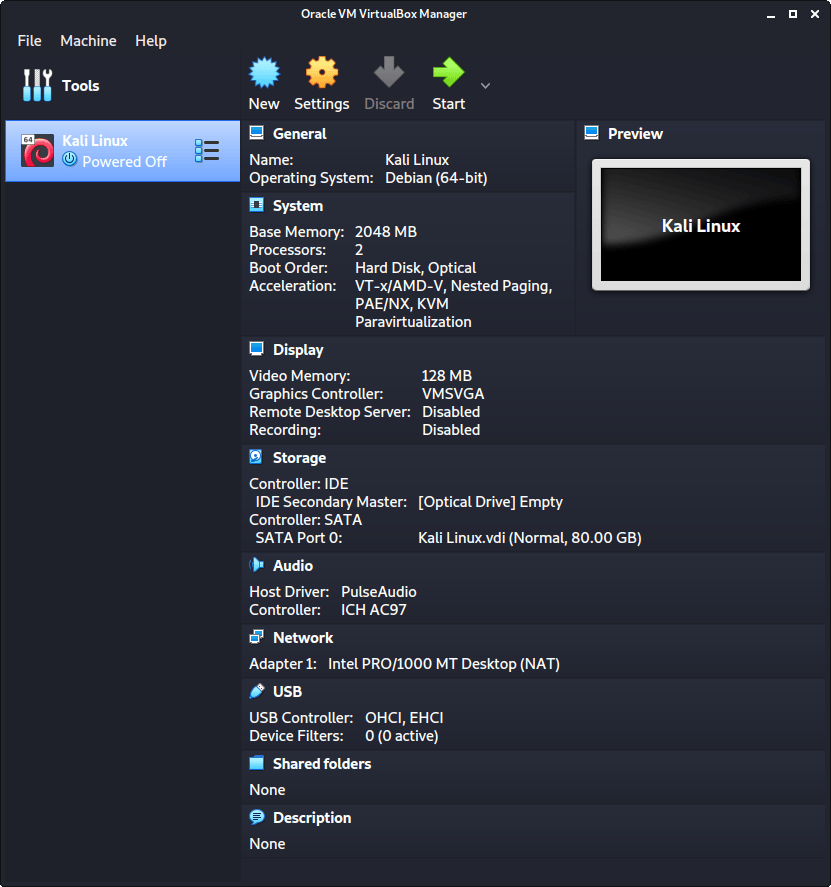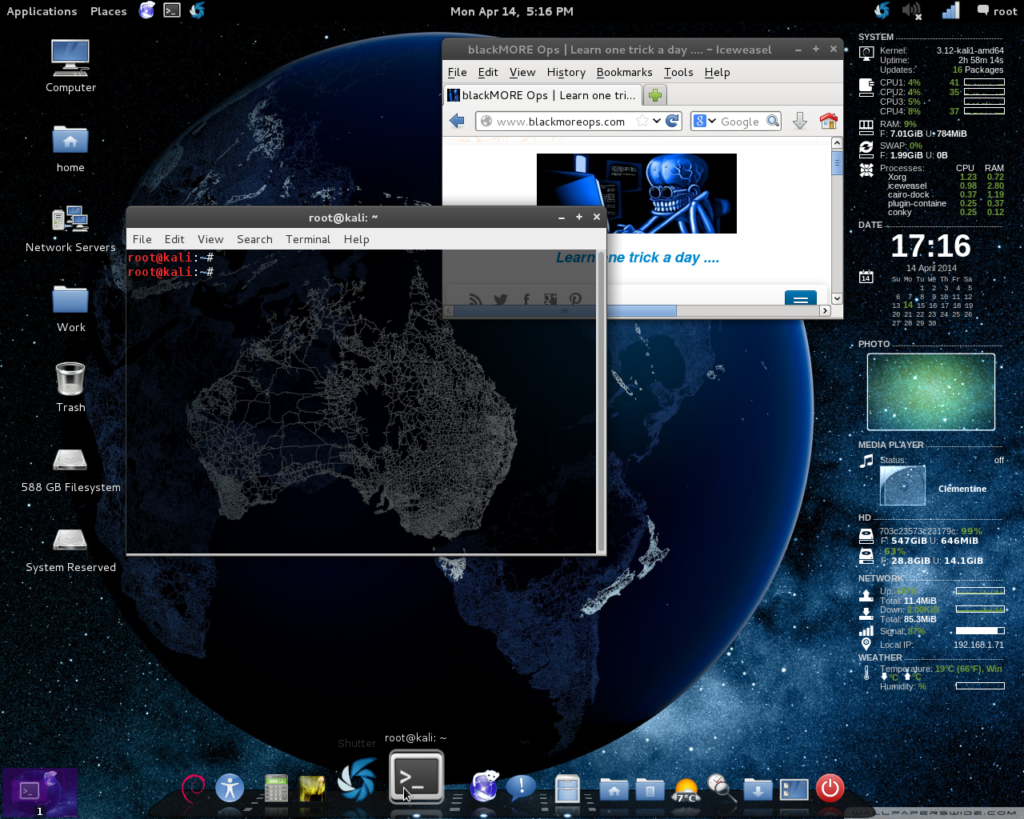- Download Kali Linux For Virtualbox 32 Bit Download
- Download Kali Linux For Virtualbox 32 Bits
- Kali Linux
First, go to the official web site and download the ISO image of Kali Linux. There are multiple 32-bit and 64-bit images that have different graphical user interfaces (Gnome, KDE, XFCE, LXDE etc.). Let’s download Kali Linux 64-bit v.2019.2 – this distribution has Gnome as a graphical user interface (GUI). Kali Linux can be download in both 32 bit and 64-bit version as ISO image or you can Download Kali Linux VMware Images, Kali Linux VirtualBox images and also Kali Linux Hyper-V images. Let’s take a look at how to download and install Kali Linux on VMware. Deploy OVA Template Kali on VirtualBox. This method of installing Kali Linux on VirtualBox is much easier, as most of the settings are already enabled by default. Go to the official Offensive Security website and download the appropriate OVA template, such as the 64-bit Kali Linux VirtualBox OVA image. Now go to VirtualBox and open Tools.
List of VirtualBox Images

M = Minimal Installation / G = Graphical Installation
| Image Name | Download Link |
|---|---|
| CentOS Stream 8 | Download (M - 0.6 GB / G - NA) |
| CentOS 8.4.2105 | Download (M - 0.6 GB / G - 1.6 GB) |
| CentOS 7.9.2009 | Download (M - 0.9 GB / G - 2.2 GB) |
| CentOS 6.10 | Download (M - 0.6 GB / G - 2.1 GB) |
| AlmaLinux 8.3 Beta | Download (M - 0.6 GB / G - 1.6 GB) |
| Rocky Linux 8.4 | Download (M - 0.6 GB / G - 1.6 GB) |
| Ubuntu 21.04 | Download (2.3 GB) |
| Ubuntu 20.10 | Download (3.3 GB) |
| Ubuntu 20.04.2 (LTS) | Download (3.1 GB) |
| Ubuntu 18.04.3 (LTS) | Download (3.6 GB) |
| Ubuntu 16.04.7 (LTS) | Download (2.2 GB) |
| Ubuntu 19.10 | Download (4 GB) |
| Debian 11 | Download (1.4 GB) |
| Debian 10.7.0 | Download (1.8 GB) |
| Debian 9 | Download (2.1 GB) |
| Fedora 34 | Download (2.5 GB) |
| Fedora 33 | Download (3.1 GB) |
| Fedora 32 | Download (4.5 GB) |
| Fedora 31 | Download (7.4 GB) |
| Linux Mint 20.1 | Download (2.5 GB) |
| Linux Mint 19.3 | Download (4.3 GB) |
| Linux Mint 19.2 | Download (5.2 GB) |
| MX Linux 19 | Download (2.9 GB) |
| MX Linux 19.3 | Download (2.2 GB) |
| Manjaro 21.0 | Download (1.8 GB) |
| Manjaro 20.2 | Download (2.9 GB) |
| Manjaro 19 | Download (3.9 GB) |
| Elementary OS 6 | Download (2.2 GB) |
| Elementary OS 5.1 | Download (3 GB) |
| Solus 4.1 | Download (3.7 GB) |
| Solus 4.2 | Download (2.6 GB) |
| Deepin 15.11 | Download (3.5 GB) |
| Deepin 20.1 | Download (5.9 GB) |
| KDE neon [20200326-1117] | Download (2.5 GB) |
| antix 19.1 | Download (2.1 GB) |
| Kubuntu 21.04 | Download (2 GB) |
| Kubuntu 20.10 | Download (3.8 GB) |
| Kubuntu 20.04 (LTS) | Download (3 GB) |
| Pop!_OS 20.04 (LTS) | Download (3.9 GB) |
| Pop!_OS 20.10 | Download (3.1 GB) |
| Linux Mint 20 | Download (3.5 GB) |
| openSUSE Leap 15.2 | Download (2.2 GB) |
| EndeavourOS 2021.02.03 | Download (2.5 GB) |
| EndeavourOS 2020.09.20 | Download (3.8 GB) |
| Lubuntu 21.04 | Download (1.8 GB) |
| Lubuntu 20.10 | Download (2.3 GB) |
| Lubuntu 20.04.1 (LTS) | Download (3.5 GB) |
| Lubuntu 18.04.5 (LTS) | Download (2.3 GB) |
| Arch Linux 2020.10.01 | Download (1.1 GB) |
| Arch Linux 2021.01.01 | Download (1.3 GB) |
| Android-x86 9.0-r2 | Download (32-Bit - 940MB / 64-Bit - 1 GB) |
| Ubuntu Kylin 20.04 (LTS) | Download (3.6 GB) |
| Ubuntu Kylin 20.10 | Download (3.7 GB) |
| ArcoLinux 20.11 | Download (2.9 GB) |
| Kali Linux 2021.1 | Download (4.0 GB) |
| Kali Linux 2020.04 | Download (4.1 GB) |
| PCLinuxOS 2020.10 | Download (3.4 GB) |
| Mageia 7.1 | Download (1.9 GB) |
| Mageia 7.1 | Download (1.9 GB) |
| Garuda Linux 201205 | Download (2.5 GB) |
| Q4OS 3.13 | Download (1.3 GB) |
| Zorin OS 15.3 Core | Download (2.7 GB) |
| Xubuntu 20.04.1 LTS | Download (2.2 GB) |
| Ubuntu MATE 21.04 | Download (2.1 GB) |
| Ubuntu MATE 20.10 | Download (2.8 GB) |
| Ubuntu MATE 20.04.2 LTS | Download (2.7 GB) |
| Ubuntu MATE 18.04.5 LTS | Download (2.7 GB) |
| Peppermint 10 | Download (2.1 GB) |
| Devuan 3.1.0 | Download (1.7 GB) |
| Endless OS 3.9.0 | Download (5.0 GB) |
| GeckoLinux 152.210223 | Download (1.8 GB) |
| KaOS 2021.01 | Download (2.8 GB) |
| KaOS 2021.01 | Download (2.8 GB) |
| Artix Linux 20210101 | Download (1.8 GB) |
| PureOS 9.0 | Download (1.6 GB) |
| Parrot OS Security 4.10 | Download (3.8 GB) |
| Feren OS 2021.01 | Download (2.1 GB) |
| Ubuntu Studio 20.04.2 LTS | Download (3.1 GB) |
| Bodhi Linux 6.0.0 | Download (1.3 GB) |
| Linux Lite 5.4 | Download (1.9 GB) |
IMPORTANT! Never download Kali Linux images from anywhere other than the official sources.
Always be sure to verify the SHA256 checksums of the file you’ve downloaded against our official values.
It would be easy for a malicious entity to modify a Kali installation to contain exploits or malware and host it unofficially.
Where to Get Official Kali Linux Images
ISO Files for Intel-based PCs
In order to run Kali “Live” from a USB drive on standard Windows and Apple PCs, you’ll need a Kali Linux bootable ISO image, in either 32-bit or 64-bit format.
If you’re not sure of the architecture of the system you want to run Kali on, on Linux or macOS, you can run the command uname -m at the command line. If you get the response, “x86_64”, use the 64-bit ISO image (the one containing “amd64” in the file name); if you get “i386”, use the 32-bit image (the one containing “i386” in the file name). If you’re on a Windows system, the procedure for determining whether your architecture is detailed on Microsoft’s website.
The Kali Linux images are available both as directly downloadable “.iso/.img” files or via “.torrent” files.
Download Kali Linux For Virtualbox 32 Bit Download
Building your own Kali Linux ISO, standard or customized, is a very simple process.
Virtual Machines Images

If you want to run Kali Linux as a “guest” under VMware or VirtualBox, Kali Linux is available as a pre-built virtual machines with any guest tools already installed. These image are available in a 64-bit (amd64), and 32-bit PAE (i*86) formats.
ARM Images

The hardware architectures of ARM-based devices vary considerably, so it is not possible to have a single image that will work across all of them. Pre-built Kali Linux images for the ARM architecture are available for a wide range of devices.
Scripts for building your own ARM images locally are also available on GitLab. For more details, see the articles on setting up an ARM cross-compilation environment and building a custom Kali Linux ARM chroot.
Verifying Your Downloaded Kali Image
Why do I need to do this?
Before you run Kali Linux Live, or install it to your hard disk, you want to be very sure that what you’ve got actually is Kali Linux, and not an imposter. Kali Linux is a professional penetration testing and forensics toolkit. As a professional penetration tester, having absolute confidence in the integrity of your tools is critical: if your tools are not trustworthy, your investigations will not be trustworthy, either.
Moreover, as the leading penetration testing distribution, Kali’s strengths mean that a bogus version of Kali Linux could do a tremendous amount of damage if it were deployed unwittingly. There are plenty of people with plenty of reason to want to stick very sketchy stuff into something that looks like Kali, and you absolutely do not want to find yourself running something like that.
Avoiding this is simple:
Download Kali Linux For Virtualbox 32 Bits
- Only download Kali Linux via the official download pages at kali.org/downloads/ or offensive-security.com/kali-linux-vmware-arm-image-download/ - you will not be able to browse to these pages without SSL; encrypting the connection makes it much harder for an attacker to use a “man-in-the-middle” attack to modify your download. There are a few potential weaknesses to even these sources - see the sections on verifying the download with the SHA256SUMS file and its signature against the official Kali Development team private key for something much closer to absolute assurance.
- Once you’ve downloaded an image, and before you run it, always validate that it really is what it’s supposed to be by verifying its checksum using one of the procedures detailed below.
There are several methods for verifying your download. Each provides a certain level of assurance, and involves a corresponding level of effort on your part.
- You can download an ISO image from an official Kali Linux “Downloads” mirror, calculate the ISO’s SHA256 hash and compare it by inspection with the value listed on the Kali Linux site. This is quick and easy, but potentially susceptible to subversion via a DNS poisoning: it assumes that the site to which, for example, the domain “kali.org” resolves is in fact the actual Kali Linux site. If it somehow were not, an attacker could present a “loaded” image and a matching SHA256 signature on the fake web page. See the section “Manually Verify the Signature on the ISO (Direct Download)”, below.
- You can download an ISO image through the torrents, and it will also pull down a file - unsigned - containing the calculated SHA256 signature. You can then use the shasum command (on Linux and macOS) or a utility (on Windows) to automatically verify that the file’s computed signature matches the signature in the secondary file. This is even easier than the “manual” method, but suffers from the same weakness: if the torrent you pulled down is not really Kali Linux, it could still have a good signature. See the section “Verify the Signature on the ISO Using the Included Signature File (Torrent Download)”, below.
- To be as close to absolutely certain as possible that the Kali Linux download you’ve obtained is the real thing, you can download both a cleartext signature file and and version of the same file that has been signed with the official Kali Linux private key and use GNU Privacy Guard (GPG) to first, verify that the computed SHA256 signature and the signature in the cleartext file match and second, verify that the signed version of the file containing the SHA256 hash has been correctly signed with the official key.
If you use this more complicated process and successfully validate your downloaded ISO, you can proceed with pretty complete assurance that what you’ve got is the official image and that it has not been tampered with in any way. This method, while the most complex, has the advantage of providing independent assurance of the integrity of the image. The only way this method can fail is if the official Kali Linux private key is not only subverted by an attacker, but also not subsequently revoked by the Kali Linux development team. For this method, see the section on verification using the SHA256SUMS file.
What do I need to do this?
If you’re running on Linux, you probably already have GPG (GNU Privacy Guard) installed. If you’re on Windows or macOS, you’ll need to install the appropriate version for your platform.
- If you’re on a PC running Windows, download and install GPG4Win from here. Certain versions of Windows do not have the native ability to calculate SHA256 checksums. To check this, you can open the command prompt and run
certutil -?. If you do have this installed, you can runcertutil -hashfile kali-linux-2021.3-live-amd64.iso sha256to verify your download. If you do not havecertutilinstalled, you will also need a utility such as Microsoft File Checksum Integrity Verifier or Hashtab to verify your download. - If you’re on a Macintosh running macOS, download and install GPGTools from here. Alternatively, if you have Homebrew installed, just run
brew install gnupg
Once you’ve installed GPG, you’ll need to download and import a copy of the Kali Linux official key. Do this with the following command:

or the command
Your output should look like this:
Verify that the key is properly installed with the command:
The output will look like this:

You’re now set up to validate your Kali Linux download.
How Do I Verify My Downloaded Image?
Manually Verify the Signature on the ISO (Direct Download)
If you downloaded the ISO directly from the downloads page, verify it using the following procedure.
On Linux, or macOS, you can generate the SHA256 checksum from the ISO image you’ve downloaded with the following command (assuming that the ISO image is named “kali-linux-2021.3-live-amd64.iso”, and is in your current directory):
The output should look like this:
The resulting SHA256 signature, “e316b27025922e9f6bca0cacee6dde83dbfd4a549ad18026526f5824af639fc1”, can be seen to match the signature displayed in the “sha256sum” column on the official download page for the 64-bit Intel architecture Kali Linux 2021.3 ISO image:
Verify the Signature on the ISO Using the Included Signature File (Torrent Download)
If you downloaded your copy of the Kali Linux ISO image via the torrents, in addition to the ISO file (e.g. kali-linux-2021.3-live-amd64.iso), there will be a second file containing the computed SHA256 signature for the ISO, with the extension “.txt.sha256sum” (e.g. kali-linux-2021.3-live-amd64.txt.sha256sum). You can use this file to verify the authenticity of your download on Linux or macOS with the following command:
If the image is successfully authenticated, the response will look like this:
IMPORTANT! If you are unable to verify the authenticity of the Kali Linux image you have downloaded as described in the preceding section, do NOT use it! Using it could endanger not only your own system, but any network you connect to as well as the other systems on that network. Stop, and ensure that you have downloaded the images from a legitimate Kali Linux mirror.
Verify the ISO Using the SHA256SUMS File
This is a more complex procedure, but offers a much higher level of validation: it does not rely on the integrity of the web site you downloaded the image from, only the official Kali Linux development team key that you install independently. To verify your image this way for an Intel architecture version of Kali, you will need to download three files from the Kali “Live CD Image” site for the current release (v2021.3, as of this writing):
- The ISO image itself (e.g. kali-linux-2021.3-live-amd64.iso)
- The file containing the calculated SHA256 hash for the ISO, SHA256SUMS
- The signed version of that file, SHA256SUMS.gpg
Before verifying the checksums of the image, you must ensure that the SHA256SUMS file is the one generated by Kali Linux. That’s why the file is signed by Kali’s official key with a detached signature in SHA256SUMS.gpg. If you have not already done so, Kali’s official key can be downloaded and imported into your keychain with this command:
or this command
Your output should look like this:
You should verify that the key is properly installed with the command:
The output will look like this:
Kali Linux
Once you have downloaded both SHA256SUMS and SHA256SUMS.gpg, you can verify the signature as follows:
If you do not get that “Good signature” message or if the key ID does not match, then you should stop and review whether you downloaded the images from a legitimate Kali Linux mirror. The failed verification strongly suggests that the image you have may have been tampered with.
If you did get the “Good signature” response, you can now be assured that the checksum in the SHA256SUMS file was actually provided by the Kali Linux development team. All that remains to be done to complete the verification is to validate that the signature you compute from the ISO you’ve downloaded matches the one in the SHA256SUMS file. You can do that on Linux or macOS with the following command (assuming that the ISO is named “kali-linux-2021.3-live-amd64.iso” and is in your working directory):
If the image is successfully authenticated, the response will look like this:
If you do not get “OK” in response, then stop and review what’s happened: the Kali image you have has apparently been tampered with. Do NOT use it.
Once you’ve downloaded and verified your image, you can proceed to create a bootable “Kali Linux Live” USB drive.



